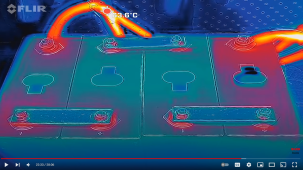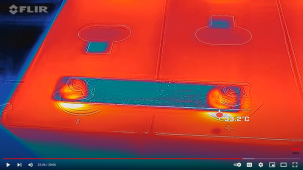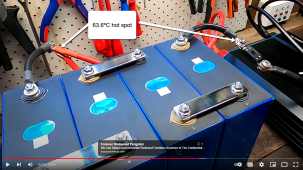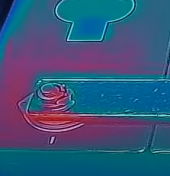Where did you get the torque spec? I have EVE 280k cells with the M6 welded studs with the smallish ≈10mm conctact area.
One of the EVE data sheets provides that specification for rotational torque on the terminal itself.
Where did you get the torque spec? I have EVE 280k cells with the M6 welded studs with the smallish ≈10mm conctact area.
Where did you get the torque spec? I have EVE 280k cells with the M6 welded studs with the smallish ≈10mm conctact area.
I hate the new cells for that reason. It's like a built-in defect. Mine were the ones with the large flat internal threaded terminals. Massive contact area and worked great with grub screws.
I have seen several videos about the small contact area and surprisingly it doesn't seem to matter. If it is in fact not capable of carrying the required current this fact will manifest itself by the contact area getting hotter than the surrounding surfaces. When tested, the contact area remains cooler than the buss bar or the cells, so it is not a problem. Here is a video of a test with 160A for 20-minuts then 230A for an additional 10-minuts with no heating. The good stuff with a flir camera begins at 22:25. I bought my 280K's with these terminals after watching this test.Agreed. I would have a tough time buying another set of cells at this time because of the funky terminals. The one version that has two connection points would be OK. But that dinky contact area that you refer to really bothers me.

I would say that you grabbed the wrong screenshot. The max temperature on the studs is 33.2ºC and the background temperature of the work bench is 24.7ºC so that is a 8.5ºC rise with 230A for 10-minutes. That is a great result and I do not hesitate to use mine for that purpost. I ahve them connected in a 2p4s configuration with a JK 4S2A20P BMS. Even if I use the max over current limit of 350A that will be 175A per post and only 76% of what Andy tested to. In reality, I will not be going over 200A or 100A per post for more than a few seconds (30s is what I have the overcurrent cutoff set to) so I will be at 43% of this test so I am good with the more robust welded studs rather than the drill/tap terminals that so many have reported stripping.  Those glowing orbs in your screenshot are all in wires and crimps and have nothing to do with the welded studs.There's a difference between "this is a good design" and "this is not a problem".
Not sure what you're looking at. I watched the video you linked and saw the opposite.
View attachment 121552
The FLIR imaging confirms it for me... it's a bad design. The fact that there's a temperature rise at all indicates a point of resistance. Those connections very nicely add 8 additional resistors.

I have seen several videos about the small contact area and surprisingly it doesn't seem to matter. If it is in fact not capable of carrying the required current this fact will manifest itself by the contact area getting hotter than the surrounding surfaces. When tested, the contact area remains cooler than the buss bar or the cells,
so I am good with the more robust welded studs rather than the drill/tap terminals that so many have reported stripping.
Those glowing orbs in your screenshot are all in wires and crimps and have nothing to do with the welded studs.
I guess I am not seeing the same things you are seeing. Can you show a screen shot where any of the connection points between the buss bar and the stud are more than 10ºC (about 37ºC) above the room temperature? I cannot.No portion of the video showed this. It showed the opposite.
I take it you've not seen the reports of the welded studs coming off?
The reports of stripping were 100% over-torque and the fault of the user EXCEPT in cases where shoddy cells were supplied. Tapped threads with grub screws and a properly torqued nut yield a notably superior connection. Surface area and pressure are your friend when making terminal connections.
Not possible. The sensing wires and crimps carry essentially zero current.
Again, this comes down to a difference between "not a problem" vs. "good design."
The welded studs are an inferior design. Period.

I guess I am not seeing the same things you are seeing.
Can you show a screen shot where any of the connection points between the buss bar and the stud are more than 10ºC (about 37ºC) above the room temperature? I cannot.





